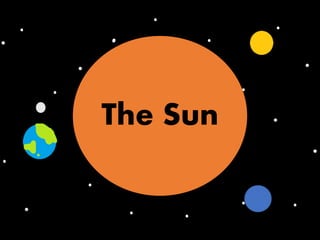
THE SUN
- 1. The Sun
- 2. What does the Sun do? The Sun is a huge star in the center of our solar system. The Sun provides the Earth with light and heat so we and all the other living things on Earth can Survive, like Humans, Animals, Plants, and more. The Sun can Provide Electricity for our Houses and power many things, using solar panels.
- 3. Image of the Sun
- 4. Fact #1 about the Sun! The Sun is 100,000kms wide and tall! The Sun is a huge star, But it’s the not the biggest thing in the Solar System or Milky Way, they is way more stars!
- 5. Fact #2 about the Sun! The Sun is Millions of Miles away from Earth. Mercury is the closet to the Sun, Venus is second, Earth, Mars, Jupiter, Saturn, Uranus and then Neptune. Pluto used to be a planet but it is now considered a ‘Dwarf Planet’ because is rotated differently to all the other planets in the System.
- 6. Fact #3 about the Sun! The Sun is formed from cloud of hydrogen gas and dust, 5 billion years ago. The Sun holds 99.85% of the mass of our solar system, 92% hydrogen and 8% helium, Core is 27 million degrees Fahrenheit Nuclear reactions of hydrogen atoms being forced together under high temperature and pressure to form helium * heat is from nuclear reactions.
- 7. Fact #4 about the Sun! The Sun is a huge Star, But it’s not the only Star in the solar system or in space. There are plenty of Stars in the solar system, and in space. Some of the stars have been discovered but there are plenty of more to discover. The stars in the solar system are very hot, the temperature is more then 1000, 000 degrees- Fahrenheit. The outer stars are more bigger, in fact once we discover new ones, they are bigger and hotter than all the other ones we had discovered
- 8. Fact #5 about the Sun! People think that the sun is the color yellow or orange but it’s really not. The Sun Star is the color white. How is the sun white? Because they are plenty of pollution and litter on Earth. The rubbish will reflect on the sun in the sky then it will give it an orange or yellow color to us, but if there was no pollution on Earth the sun will be white to us.
- 9. Sun -- * middle-sized yellow star * formed from cloud of hydrogen gas and dust, 5 billion years ago * holds 99.85% of the mass of our solar system * 92% hydrogen and 8% helium * Core is 27 million degrees Fahrenheit * nuclear reactions of hydrogen atoms being forced together under high temperature and pressure to form helium * heat is from nuclear reactions Terrestrial planets – dense planets Mercury -- * orbit 88 Earth days, rotation 58 ½ Earth years * 800° F on the Sun side to -297° F on the dark side * no atmosphere because so small * covered in craters, bombarded with asteroids and comets * grey * mostly iron and very dense Venus -- * orbit 225 earth days, rotation 243 days; day is longer than its year * 908° F to 710° F * thick carbon dioxide atmosphere keeps temperatures hotter than Mercury, 90 times the atmospheric pressure of earth * only planet to rotate clockwise * many volcanoes * yellowish – white Earth -- * only planet we know has life * orbit 365 days, rotation 24 hours * -100° F to 120° F * atmosphere with oxygen * liquid water is abundant * bluish – green Mars -- * Orbit 2 earth years, rotation 24 hours and 30 minutes * - 117° F to - 27° F * thin carbon dioxide atmosphere * red - orange color, covered in rust * polar ice caps, liquid water in the past * 2 rovers on its surface
- 10. Jupiter -- * largest planet, made of gas with icy core * orbits 12 years, rotates every 9 hours * faint rings * atmosphere filled with storms and lightning * winds up to 250 mph * Giant Red Spot, massive storm raging for the last 300 years * orange, brown, red and white bands * – 145° F * 50 moons Saturn -- * second largest planet, gas with solid icy core * least dense, made of hydrogen and helium * winds 1100 mph * largest and most beautiful rings; made of ice, dust and rocks, up to 1000 rings in total * rings are 150,000 miles wide but only half a mile thick * pale yellow * - 178° F * orbits 30 years, rotates every 10 hours * 53 moons Uranus -- * gas planet with rocky, icy core * faint rings * light blue-green color due to methane gas atmosphere * 84 years to orbit, rotates on its side every 17 hours. Side rotation may be due to a large object smashing into it or a moon being pulled out of it * – 350° F * 27 moons Neptune -- * gas planet with rocky, icy core * faint rings, * Light blue color due to methane gas atmosphere * Cloud moving quickly across the planet * Fastest winds of 1250 mph * 165 years to orbit, rotates every 16 hours * – 392° F * 13 moons